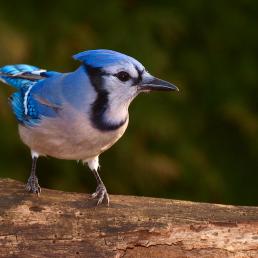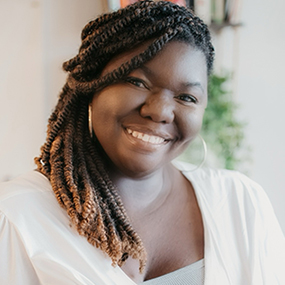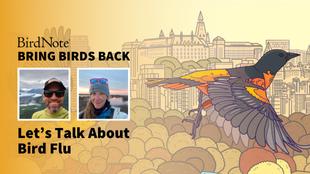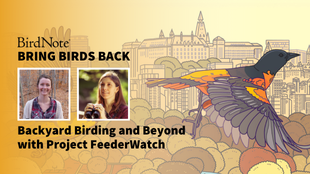

Join BirdNote tomorrow, November 30th!
Illustrator David Sibley and actor H. Jon Benjamin will face off in the bird illustration battle of the century during BirdNote's Year-end Celebration and Auction!
Tenijah got hooked on birding at the start of the pandemic, and during the last season of Bring Birds Back she learned a lot about our feathered friends. This season, she’s ready to learn and share more simple ways to help birds — while discovering new birding skills from experts. After going birding with her mom and not seeing much, Tenijah wants to know how to better find and identify birds around her. Conor Gearin, managing producer of BirdNote Daily, joins Tenijah to teach her how to identify who you’re seeing outside and why they’re there.
Tenijah Hamilton: BirdNote Presents…
[Echoing Wingflaps SFX]
Tenijah Hamilton: From BirdNote, this is season two of Bring Birds Back! I’m Tenijah Hamilton.
[Energetic music with birdsong begins]
Tenijah Hamilton: It is springtime here in Atlanta and my life is a 24/7 chirpfest.
Big birds, small birds, gray birds, brown birds, ground birds, sky birds, catching a meal on the wing and eating flies birds…
…they all like to chit chat at about 5:30 am. The best I can do to get back to sleep is throw a pillow over my head, but honestly… I kind of love just laying there and listening and appreciating. Their songs are delightful, of course.
But there’s another thing: these birds are in the fight of their lives. We can’t take for granted that they’ll always be around. I mean, you may remember this statistic from last season:
Tenijah Hamilton (from previous episode):In 2019, a landmark study was published in the journal Science, finding that we've lost almost 30% of all North American birds in the past fifty years alone. That is three billion birds, billion with a B, in only one generation!
Tenijah Hamilton: I can’t help but think about my chatty Carolina Wrens and robins, and their early morning songs, like a defiant act of resistance — a literal wake-up call, saying “we’re still here.” And it reminds me of just how much I want to make sure I am doing my part so that they stay here.
That means that I’ve spent a lot more time outside. Sometimes I see some really cool birds in these gorgeous locations like nature preserves and marshes. Like, recently, I lost *all* ability to be cool at my first sighting of a Bald Eagle.
Or, a couple weeks ago, I took my mom to a new park in Atlanta.
You remember my mom. She, uh, very spiritedly let y’all know that I didn’t spend too much time in nature back in season 1:
Mom (from previous episode): If it was summer, you didn't like the heat. If it was winter, you didn't like the cold. You definitely didn't like the bugs. And more than anything else, you didn't like squirrels.
Tenijah Hamilton: I wanted to show her how much I’ve grown and to share all the stuff I’ve learned about birds! But when we got to the park, we saw…
[Sound of roaring waterfall fades in]
Tenijah Hamilton: (Singing) 🎵We found a waterfall…🎵 But not a lot of birds.
Tenijah Hamilton: Nothing. Nada. Zilch.
[Sounds of a peaceful stream]
Tenijah Hamilton: WHERE ARE THE DUCKS!?!?!
Mom: They need to give us some love and come closer!
[Water fades out, sounds of urban park remain — breezy trees, a motor rumbling in the distance]
Tenijah Hamilton: Yep, nature will humble you like that.
Tenijah Hamilton: There's more ground birds hopping around at my house than we see here.
Tenijah Hamilton: At first I was feeling kinda defeated. A little embarrassed. I mean I wanted to show off to my mom, and this was definitely not that. But as we continued to explore the park…
[sound of footsteps along trail]
Tenijah Hamilton: Did somebody carve “DONDA” into that tree? Is that what that says?
Tenijah Hamilton: …it felt like nature was reminding me of lesson number one: birding is supposed to be fun. Even when you can’t find a bird you’re excited about, you can take joy in just being outside, finding the marvelous in the mundane.
Mom: Oh, you can take such a deep breath out here with the greenage. The air feels fresh going down.
Tenijah Hamilton: Mhm.
Tenijah Hamilton: And as I began to take this to heart, we had a little change in our luck.
Tenijah Hamilton: Ah!
Mom: There's something, yup! What was he?
Tenijah Hamilton: He flew right in front of us over the water into a little tree… Gray with, um, a white band around the wing.
Mom: You've got all of that just from him flying past us? That means you have definitely been a lot more observant of birds.
Tenijah Hamilton: First off, that was a Northern Mockingbird. And second — she’s right! The joy of birding has absolutely made me more observant.
And that’s what I try to share with my family and my friends. I encourage them to stop and invite them to become fully present in their surroundings and I ask: what do you hear? What do you see?
Mom: Ah! There’s one!
Tenijah Hamilton: Oh he’s tiny!
Mom: Little itty-bitty!
Tenijah Hamilton: And that feeling. That feeling there? That’s how I get them.
Mom: And he's just hanging around, just flitting in front of us on this tree.
[Park sounds fade out]
Tenijah Hamilton: This season, I’m trying to find my people, find community outside. Of course I’ll be finding more ways we can all help our feathered friends. And I’m also trying to become a better birder.
I have learned so much about birds and birding in the past two years, and now, I’d really love to apply some of that in the field. But here’s the incredible part of what I’ve already learned—the field is anywhere I want it to be! From my window sill— birding. On a trek through some woods—also birding. Looking out from the passenger seat on the way to the grocery store? Yep, still birding. If you like birding… you’re a birder. And if you’re consistently learning and trying… then guess what? You’re on your way to being a better birder.
But it’s more than just that. It’s also about being a more thoughtful and ethical birder. Learning to protect and preserve nature, and to be kind to the birders around me. How can I lessen the possibility that I disturb the birds? How can I ensure that I am doing what I can to make these spaces more accessible in every sense of the word?
I want to start off the season learning from someone who could help me level-up and add to my personal birding toolkit. Specifically, being able to connect birds to a place — who’s going to be in a spot, and why?
So today we have a very special guest from the home team. We have Conor Gearin and he is the managing producer of BirdNote daily. Hi Conor.
Conor Gearin: Hi, Tenijah, it's great to be here.
Tenijah Hamilton: Tell us a little bit about what you're going to be talking about today and what we're going to do.
Conor Gearin: Yeah. So calling this a crash course on birds and the theme here is connecting birds to a place. There are specific reasons why you see a certain bird species in a particular place. And that really helped me, I think, move beyond just, well, this was the list of species I saw. Like that for me, that's not enough. I want to know more about, like, their homes and how they live and all this stuff.
Tenijah Hamilton: What I really like about that is, I think it's reflective of a little bit of where I am with my journey as well. Like I'm, I'm to the point where I see the birds and, you know, I'm kind of learning about them, but it doesn't quite feel connected yet.
Conor Gearin: Absolutely. I think it is a common experience. You sort of learn the cast of characters, in a sense, your typical neighborhood birds, but you don't know the why's like, why these species and, what other species might I expect to see in the places I normally go to? And just having the reasons behind all these things
Tenijah Hamilton: Alright, so where should I start for all of this? How do we connect the dots on these birds?
[Jaunty guitar music begins]
Conor Gearin: Ok, so when you're ID'ing a bird, I think you actually have to start with, where am I? Rather than anything else to do with what the bird sounds like or looks like. Where are you?
So on the largest scale you have the region. For both of us that’s the Eastern US.
Zoom in and you start to get landscapes. This is like a birds’ eye view of a few square miles. For me that’s a pretty urban landscape with forests on the edges. So like, some birds might need to be a few hundred yards from water, or to be at least a certain distance away from a built-up urban area.
And then zooming all the way in to get to habitats that are really specific. Like, the wooded edge of someone’s backyard or a wetland behind a Walmart.
At each of these levels, birds are drawn to habitats for specific resources. They are where they are for a reason. Usually, and especially in winter, that’s for food resources.
And if you can figure out what a given habitat can offer birds, that can get you a lot of the way to solving what bird you're seeing.
[Jaunty music fades out]
Tenijah Hamilton: Yeah. Cause it seems like you're, you're pulling from a smaller dataset essentially. Like, instead of thinking about the very wide world of birds you're already kind of culling it down to keep in mind the 20 or 30 species that you know. There's an area.
Conor Gearin: Exactly. So in a sense you’re trying to build a version of the Merlin Bird ID app and the questions that it asks in your head — where are you seeing this bird, what’s it doing, how big is it, what colors do you notice? And all of those help with a kind of process of elimination.
And that can help you know what's probable, but then you also get to know what's weird. So if you see something that's not on that, kind of, shortlist of expected birds, then you're like, oh, that's interesting.
Tenijah Hamilton: So do you learn this just by memorizing, you know, robins = fields near trees or, how are you tying the birds to these places?
Conor Gearin: So that's a great question. As far as memorizing, it's less that you need to learn the habitat and more about being aware of birds’ diets and behaviors. When you start learning what these birds are actually looking for, it can help you do a couple of things. One, it can help you predict whether they're going to be where you are. Two, it can tell you actually where to look. So if you know that a bird is a ground gleaner, you're going to be looking on the ground. If it's a foliage gleaner, you're looking in the shrubs and you know, it's probably picking through leaves, lots of warblers do that. They're foliage gleaners.
Tenijah Hamilton: Real quick, uh, what do you mean by "gleaning?"
Conor Gearin: Right, so gleaning refers to how these birds feed, they're looking for different food items in a certain habitat. Let's use the example of Robin picking through the grass. So they're ignoring the grass and they're looking for insects to eat and worms. So they're gleaning. They're ignoring some of the stuff, but they're picking out certain food items.
Tenijah Hamilton: Okay, so I feel like I've got the basics here, but what if I like want to check my work? What's the best way to see if a bird sighting makes sense?
Conor Gearin: This brings up something that I wanted to talk about, which is, using eBird with a purpose. eBird is not just useful for keeping track of the birds you've seen, you can use it to find out what other people are seeing.
[Jaunty music returns]
Tenijah Hamilton: So we're going to take a quick break, but when we come back Conor's got a little game for me to test and sharpen my skills. Be right back y'all.
[Jaunty music fades out]
[MIDROLL AD BREAK]
Tenijah Hamilton: This is Bring Birds Back, I'm Tenijah Hamilton. And Conor is helping me learn how to get better at identifying some of the birds around me. So Conor, you have a little game for me today. You've picked some of those everyday habitats I might find myself in and I'm going to guess what birds I might find there, right?
Conor Gearin: Exactly. So I have a few different locations that you might pass through in your daily life. Alright so the first one,
[Wingbeats; suddenly we are hearing the sounds of a wetland marsh]
Conor Gearin: a wetland in a city, reeds and cattails, very dense, not a lot of open water. So what are some birds you might've seen in a place like this?
[Crickets chirping]
Tenijah Hamilton: Help me out here, Conor!
Conor Gearin: OK, so you might see birds like a Red-winged Blackbird.
[One Red-winged Blackbird calling, with others audible in the background]
Conor Gearin: These are birds that love marshes. They do nest there, so that's why there tends to be quite a lot of them.
You might also see a Spotted Sandpiper.
Conor Gearin: This is a shorebird, and "shorebird" is kind of a misnomer here. They can actually show up in just little puddles, along the side of a street.
And they might seem pretty different, but what these birds have in common is they're looking for certain food resources that they can find in a marsh. So both of these, we would call these ground gleaners.
Tenijah Hamilton: These categories make sense on a very, I think, intuitive level, like these birds are always in the ground and then, you know, kind of, intuit that they are part of this guild
Conor Gearin: Yeah, I totally agree. It's really based on behavior and just what you see, right? You don't need to know necessarily the Latin name for these birds. Just by seeing its behavior, that can tell you a lot about the Bird.
Alright, next location…
[Wingbeats; now we’re hearing the sounds of an urban park recorded at the Atlanta Beltline]
So here's sort of an Atlanta inspired one here: The BeltLine! So, the BeltLine, as you know, it's an urban trail, but this particular part has an open path, some shrubs and low plants to the sides, and then some taller trees beyond that. And you'll find these kinds of parks in a lot of different cities.
Tenijah Hamilton: Listeners might remember that we actually took a little field trip out to the BeltLine last summer and we planted some native plants.
Conor Gearin: Oh yeah that’s right. Do you remember what you saw that day? What kind of birds were out?
Tenijah Hamilton: We were there for the Chimney Swifts, because there were some towers. There are a couple of towers along the beltline and we were planting some native plants so that they just have more buffet options.
Conor Gearin: Yeah, absolutely. Chimney Swifts, they're aerial insectivores. They're cruising through the air, screening for insects. And the plants that you all put in, hopefully, are going to like, produce lots of insects that then these birds can eat.
Tenijah Hamilton: Ok so who else might I see here at the BeltLine?
Conor Gearin: You might see Golden-crowned kinglets.
Conor Gearin: They're tiny little spherical birds that are kind of going around the tops of trees and looking for insects in the foliage. So they're a foliage gleaner.
Uh, there's also the Orange-crowned Warbler.
Conor Gearin: Another foliage and bark gleaner looking for insects. And the reason why I think the BeltLine is a good place to look for them is that when you have like large trees and shrubs that you can see from the side, that's always a good place to look for warblers like this. If you're in like a big forest, it might be harder to actually find that bird because they can be in any tree in that whole forest and you might never see them.
Tenijah Hamilton: Ok yeah. This is probably what happened when I went out with my mom. You know, I'll be honest and say that seeing very few birds was a bit discouraging, but then I remembered that they, the birds, they have pretty good reason to be elusive. You know, predators are obviously a threat, especially during nesting season when there are like, little fledgelings babies.
Conor Gearin: Yeah I think that's a very common experience. And I’ve actually had very similar birding experiences with my mom.
Tenijah Hamilton: Yup. Gotta work harder to impress them.
Conor Gearin: That’s right. Alright, on to location number three.
[Wingbeats; we hear the sounds of people playing soccer]
[Referee whistle]
Conor Gearin: A soccer field in like a residential neighborhood. What are some of the species you might see there, you think?
Tenijah Hamilton: Hmm. My favorite game. Uh, I wonder if an area like this would be more likely to have like little squirrels or ground prey that might attract some of the bigger predatory birds. What do you think?
Conor Gearin: Yeah. I think you're spot on.
Tenijah Hamilton: Oh yeah.
Conor Gearin: So Red-tailed Hawks
Conor Gearin: They're daytime predators and big thing they're looking for is a mammal called a vole. They're active during the day. Mice, in contrast, are nocturnal. So Red-tailed Hawks, yeah, absolutely, you're often going to see them soaring above a field like that, looking for voles, looking for songbirds on the ground that they can easily kind of swoop in and grab.
Other species you might see at a ball field: Northern Flickers.
[Northern Flicker call, many “eeh eeh eeh” in a row]
Conor Gearin: This is a woodpecker that is actually a ground gleaner. Basically they're using that woodpecker bill to drill into the ground and look for arthropods and invertebrates, just like woodpeckers in trees.
[Wingbeats; we hear the sound of waves gently lapping at the edge of a lake]
Conor Gearin: Alright, our last location. A pond at a park. Just go as straightforward as you can.
Tenijah Hamilton: Some duck friends? Some geese?
Conor Gearin: Absolutely. So there's kind of two big groups of ducks we talk about. There's the dabbling ducks and then the diving ducks.
If you can still see the duck while it's eating, and usually you can see either the back or the feet are kind of swinging in the air. That's what the Mallards do. That's a dabbling duck.
[Splashes on the lake and Mallard quacks]
Conor Gearin: If it totally vanishes from the surface, it's a diving duck.
Conor Gearin: Ring-necked Ducks are a species that will actually go fully underwater and swim down to the bottom of the pond or hunt down a little aquatic insect in the water. It's kind of fun to see them disappear under the surface. And then kind of wonder when they're going to come back up.
You’ve also got piscivores, species that specialize in eating fish. So Belted Kingfishers are a great example of this.
[Belted Kingfisher splashes into the water, then makes a chittering call]
Conor Gearin: They will sort of fly above the surface of the water and then swoop down, grab a small fish and fly back to their perch and eat it.
Tenijah Hamilton: These Belted Kingfishers, I have not seen one. I would love to see one. My husband is Australian and he's always like, okay, like our next trip, we'll go bird watching. And I am obsessed with the kookaburra and I know the kookaburra is a kingfisher. And so I feel like if I was to see a Belted Kingfisher, I'd be real jazzed about it, cause they look like a kookaburra. Different coloring and obviously a different bird, but same family.
Conor Gearin: Right. So I actually didn't know that. So kookaburras…
Tenijah Hamilton: Did I teach you a thing?
Conor Gearin: Oh absolutely.
Tenijah Hamilton: Oh Yes!!!!
Conor Gearin: Yeah.
Tenijah Hamilton: The power!!!!
Conor Gearin: Well I'm excited that maybe you're starting a Kingfisher quest here.
Tenijah Hamilton: Yeah!
[Lake ambience fades out, energetic optimistic music with birdsong enters, solo for a few seconds]
Conor Gearin: Wrapping this up here, I think the takeaway I want to leave you with is like finding those frameworks for your knowledge that can help you like, categorize birds so that it's not just like an endless list of random bird species. Like, for me, that’s not a lot of fun, you know— okay, I've seen these 50 birds. Well, what does that mean? Like what are their relationships with habitat and with their food resources? So if you can find something that works for you and helps you categorize why you see the birds in the places that you do, that can really like, take your birding to the next level.
Tenijah Hamilton: Thank you so much, Connor.
Conor Gearin: Thanks for having me on and keep me posted on your quest to see the kingfisher.
[Energetic music solo for a few seconds]
Tenijah Hamilton: I hope that in this season of Bring Birds Back, we can all be students and that we can approach each of these episodes excited to learn and grow. Maybe you’ll start challenging your assumptions about who a birder is and who they aren’t. And along the way you might find your community, your people, who make the journey all the more worthwhile.
I’m thinking about that moment with my mom, when we spotted that mockingbird… more than my keen sense of observation, I was proud that we were out and able to just be in that stillness. Because here we were, two girls from the concrete jungle somewhere in a Georgia forest, looking at the brush and trying to catch birds in our binoculars, just waxing poetic about tree roots. And it was fantastic.
Tenijah Hamilton: You know what? I think you're a fledgling nature girl, that's what I think.
Mom: I enjoy time in nature. I absolutely do. I just don't give it to myself a lot. But I'm in awe of it whenever I come out.
Tenijah Hamilton: Bring Birds Back is produced by Mark Bramhill and me, Tenijah Hamilton. Sam Johnson is our production assistant. We're edited by Allison Behringer and Oluwakemi Aladesuyi of Rough Cut Collective. Our fact checker is Conor Gearin. Our Content Director is Allison Wilson. Scoring is by Cosmo Sheldrake and Blue Dot Sessions. Special thanks to Viki Merrick, Rehka Murthy, and of course, my momma.
[Energetic music ends]
######################
SFX:
Bird sounds provided by The Macaulay Library of Natural Sounds at the Cornell Lab of Ornithology, Ithaca, New York. ML191179 Red-winged Blackbird recording by Wil Hershberger. ML346813501 Spotted Sandpiper recording by Joe Demko. ML101484891 - Chimney Swift recording by Robert Bethel. ML120334631 - Golden-crowned Kinglet recording by Jocelyn Lauzon. ML206459 - Orange-crowned Warbler recording by Bob McGuire. ML229578 - Red-tailed Hawk recording by David McCartt. ML84808 - Northern Flicker (Yellow-shafted) recording by Wil Hershberger. ML260794071 - Mallard recording by https://www.aladdin.st/.
ML56868641 - Ring-necked Duck recording by John G Woods. ML242432331 - Belted Kingfisher recording by Jay McGowan.
“QP12 1508 Canyons evening crickets birds faint”, “QP09 1186 Wetlands lake lap birds V2”, “QP09 1195 Wetlands lake lap moderate splashes close”, and “QP01 0135 Desert bird wings flutter” recordings provided by Quiet Planet.
“Soccer game city whistles quiet noise 172s DUFFERIN GROVE 190903” by user TRP on Freesound.org
MUSIC:
“Skylark” and “Dawn Chorus” by Cosmo Sheldrake
“Ghost Byzantine” by Blue Dot Sessions
About guest Conor Gearin:
Conor Gearin is the Managing Producer of BirdNote Daily. He writes, edits and produces shows for the daily radio program and podcast, and supports the production of BirdNote's longform podcasts. His work has appeared in The Best American Science and Nature Writing 2019, The Atlantic, UnDark, The Millions, The New Territory, New Scientist and elsewhere. He received an S.M. in Science Writing at the Massachusetts Institute of Technology and an M.S. in Biology at the University of Nebraska Omaha, where he completed thesis research on grassland bird conservation. Raised in St. Louis, he developed an interest in the native songbirds of the Midwest, which led to a career focused on studying birds and exploring ways that people and wildlife can live together sustainably. He now lives in Rhode Island.












